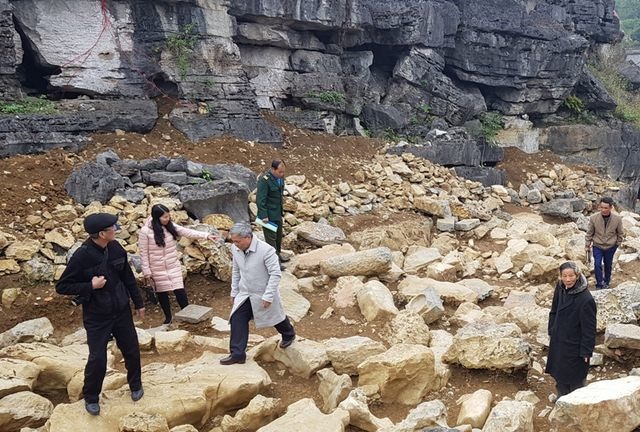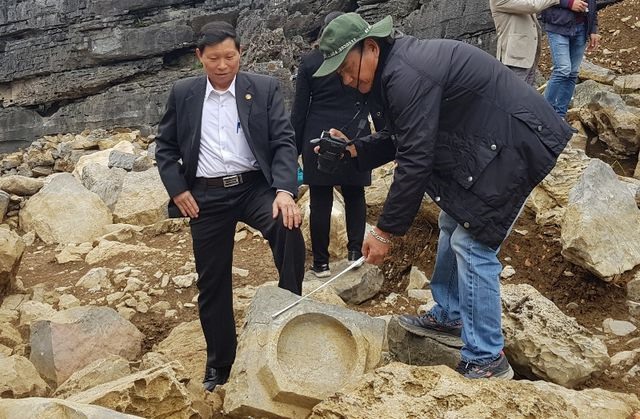 Life & Style
Life & Style

Remnants of the foundations of a 10th century pagoda in Xuân Đài Mountain, Vĩnh Lộc District, the central province of Thanh Hóa, have just been excavated.
 |
| Rock-solid proof: Scientists search the Xuân Đài Mountain site. They have uncovered big stones that served as Thông Pagoda’s foundation. — Photo dantri.vn |
THANH HÓA — Remnants of the foundations of a 10th century pagoda in Xuân Đài Mountain, Vĩnh Lộc District, the central province of Thanh Hóa, have just been excavated.
The results have been announced recently by scientists from Hồ Citadel Heritage Preservation Centre and the Việt Nam Archaeology Institute.
At an excavation site on the mountainside behind Vĩnh Ninh Primary School, archaeologists discovered four layers of foundations constructed from large stones. Most of the stones remain in their original places, arranged in a line running east to west. Some of them fell out of line.
Each layer of the foundation has a different width and distance from the other layers. For example, the gap between the second to the third stone layer is 8.8m while the third stone layer is locates 0.5-0.7m higher than the second layer.
Around the excavation site, archaeologists found four pillars dating back to the Trần Dynasty (1225-1400). Four other fallen pillars from the Lê Trung Hưng Dynasty (1533-1789) were also found. The Lê Trung Hưng pillars are carved in a more sophisticated style than the ones from the Trần dynasty, according to archaeologists.
A great number of tiles from the Trần Dynasty were also found, as well as glazed ceramic tiles from the Late Lê Dynasty (1428-1527), lotus decorative patterns from the Lê Trung Hưng Dynasty and metal nails.
According to a book titled Sơ Lược Lịch Sử Văn Hóa Chùa Thông (A Quick Review of the Culture and History of Thông Pagoda) by Trần Duy Phương, “Du Anh Pagoda and Thông Cù Pagoda are other names of Thông Pagoda, which was first built in the Early Lê Dynasty (980-1009) of bricks and tiles brought from the ancient citadel in Hoa Lư (today’s Ninh Bình Province).”
At the end of the Trần Dynasty, King Trần Nghệ Tông (1370-1372) brought his daughter, princess Du Anh, to attend a local festival and get treated for an illness at the pagoda. She got healthier after consuming herbs taken from nearby Hồ Công grotto.
The King then improved the pagoda. Du Anh directly managed the construction on the building as well as the creation of statues and a bell. The pagoda was named after her.
According to researcher Nguyễn Đức Bình from the institute, the excavation site behind the school was the location of the old temple dedicated to the princess.
Another book on geology of Vĩnh Lộc District mentions there is a temple dedicated to the princess near the pagoda. “The temple is located on the mountainside.”
The eight pillars at the foundation of different periods prove the temple existed for a long time and that the structure had been renovated multiple times, Bình said.
Architectural remnants and objects unearthed at the site show that the site is even older than two other ancient structures found in the district – Hồ Citadel (built in 1397) and Nam Giao royal worship platform (1400).
Bình said the relic site must have been built on a large area, with space to protect various valuable antiques.
“As the excavation site is small, we still cannot see the whole scale of the structures,” Bình said. “The site needs to be further excavated in order to gather enough evidence and information for future preservation.”
Researcher Đỗ Quang Trọng, director of the Hồ Citadel Preservation Centre, suggested displaying the unearthed objects at the site to enhance people’s awareness of the importance of protecting heritage sited and to develop the value of the relic site.
“The site may be named one of the locality’s destinations for spiritual tourism,” he said. — VNS
 |
| Time team: Scientists examine the remnants of an ancient pillar at the site. — Photo dantri.vn |









